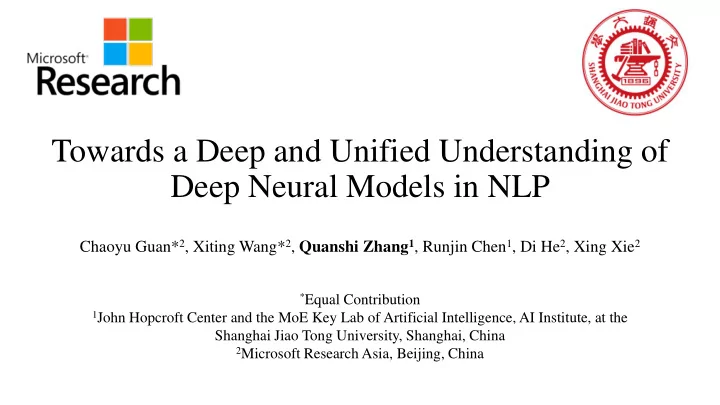

Towards a Deep and Unified Understanding of Deep Neural Models in NLP Chaoyu Guan* 2 , Xiting Wang* 2 , Quanshi Zhang 1 , Runjin Chen 1 , Di He 2 , Xing Xie 2 * Equal Contribution 1 John Hopcroft Center and the MoE Key Lab of Artificial Intelligence, AI Institute, at the Shanghai Jiao Tong University, Shanghai, China 2 Microsoft Research Asia, Beijing, China
Towards a Deep and Unified Understanding of Deep Neural Models in NLP #62 Introduction A key task in explainable AI is to associate latent representations with input units by quantifying layerwise information discarding of inputs. Most explanation methods (e.g., DNN visualization) have coherency & generality issues • Coherency: requires that a method generates consistent explanations across different neurons, layers, and models. • Generality: existing measures are usually defined under certain restrictions on model architectures or tasks.
Towards a Deep and Unified Understanding of Deep Neural Models in NLP #62 Our solution Considering both coherency and generality • A unified information-based measure: quantify the information of each input word that is encoded in an intermediate layer of a deep NLP model. • The information-based measure as a tool • Evaluating different explanation methods. • Explaining different deep NLP models • This measure enriches the capability of explaining DNNs.
Towards a Deep and Unified Understanding of Deep Neural Models in NLP #62 Problem • Quantification of sentence-level information discarding: quantify the information of an entire sentence 𝐲 that is encoded in 𝐭 . • Quantification of word-level information discarding : quantify the information of each specific word 𝐲 𝑗 that is encoded in 𝐭 . • Fine-grained analysis of word attributes : analyze the fine-grained reason why 𝐭 uses the information of 𝐲 𝑗 . 𝑈 𝑈 ∈ 𝐘 : Input sentence 𝑈 , … , 𝐲 𝑜 𝑈 : word embedding 𝐲 = 𝐲 1 𝐲 𝑗 𝐭 = Φ 𝐲 ∈ 𝐓 : hidden state Φ ⋅ : function of the intermediate layer
Towards a Deep and Unified Understanding of Deep Neural Models in NLP #62 Word Information Quantification Multi-Level Quantification Corpus level 𝑁𝐽 𝐘; 𝐓 = 𝐼 𝐘 − 𝐼(𝐘|𝐓) 𝑁𝐽(𝐘; 𝐓) 𝐼(𝐘|𝐓) 𝐼 𝐘 𝐓 = න 𝑞 𝐭 𝐼 𝐘 𝐭 𝑒𝐭 𝐭∈𝐓 𝑞 𝐲 ′ 𝐭 log 𝑞 𝐲 ′ 𝐭 𝑒𝐲′ 𝐼(𝐲) = − න Sentence level 𝐼(𝐘) 𝐲 ′ ∈𝐘 𝐼 𝐘 𝐭 = ∗ 𝐼 𝐘 𝑗 𝐭 Word level 𝐼(𝐘 𝑗 |𝐭 = Φ(𝐲)) reflects how 𝑗 much information from word ′ 𝐭 log 𝑞 𝐲 𝑗 ′ 𝐭 𝑒𝐲′ 𝑗 𝐲 𝑗 is discarded by 𝐭 during 𝐼 𝐘 𝑗 𝐭 = − න 𝑞 𝐲 𝑗 the forward propagation. ′ ∈𝐘 𝒋 𝐲 𝒋 * Suppose the words are independent in one sentence.
Towards a Deep and Unified Understanding of Deep Neural Models in NLP #62 Word Information Quantification Perturbation-based Approximation We use 𝐼(෩ 𝐘 𝑗 |𝐭) to approximate 𝐼(𝐘 𝑗 |𝐭) by minimizing the following loss: 𝑜 2 − 𝜇 𝐼(෩ 𝑀 𝝉 = 𝔽 𝝑 Φ 𝐲 − 𝐭 𝐘 𝑗 𝐭 ቚ 2 𝐉) 𝝑 𝑗 ∼𝒪(𝟏,𝜏 𝑗 𝑗=1
Towards a Deep and Unified Understanding of Deep Neural Models in NLP #62 Fine-Grained Analysis of Word Attributes Disentangle the information of a common concept 𝐝 away from each word 𝐲 𝑗 Importance of the i-th word ′ |𝐭) 𝐵 𝑗 = log 𝑞(𝐲 𝑗 |𝐭) − 𝔽 𝐲 𝑗 ′ ∈𝐘 𝑗 log 𝑞(𝐲 𝑗 concerning random words Importance of the common ′ |𝐭) − 𝔽 𝐲 𝑗 ′ |𝐭) 𝐵 𝐝 = 𝔽 𝐲 𝑗 ′ ∈𝐘 𝐝 log 𝑞(𝐲 𝑗 ′ ∈𝐘 𝑗 log 𝑞(𝐲 𝑗 concept c w.r.t. random words 𝑠 𝑗,𝐝 = 𝐵 𝑗 − 𝐵 𝐝 indicates the remaining information of the word 𝐲 𝑗 when we remove the information of the common attribute 𝐝 from the word.
Towards a Deep and Unified Understanding of Deep Neural Models in NLP #62 Comparative Study • Three baselines: LRP, gradient-based, perturbation • Conclusion: our method provides the most faithful explanations for • Across timestamp analysis Our method clearly shows that the • Across layer analysis model gradually focuses on the most • Across model analysis important parts of the sentence.
Towards a Deep and Unified Understanding of Deep Neural Models in NLP #62 Understanding Neural Models in NLP We explain four NLP models (BERT, Transformer, LSTM, and CNN): • What information is leveraged for prediction? • How does the information flow through layers? • How do the models evolve during training?
Towards a Deep and Unified Understanding of Deep Neural Models in NLP #62 Understanding Neural Models in NLP • Bert and Transformer use words for prediction, while LSTM and CNN use subsequences of sentences for prediction. • Different models process the input sentence in different manners.
Towards A Deep and Unified Understanding of Deep Neural Models in NLP Please visit our poster at #62 !
Recommend
More recommend